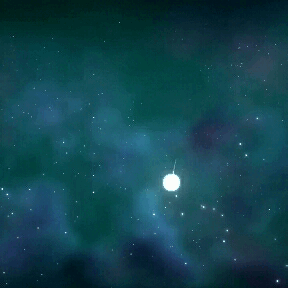No Man’s Sky is an absolutely hugely anticipated title releasing in just over a month; and whilst a lot of information about the game exists, not much of it has been collected and presented as a whole. So I’ve scoured the far reaches of the internet and pawed my way through videos, interviews and reports so that I can bring you our complete guide to No Man’s Sky.
The Art:
“No Man’s Sky is procedurally generated, but we always want it to have a unique recognisable style, to look like a science fiction book cover come to life.” – source
The art of No Man’s Sky is quite a unique thing. The whole world is procedurally generated, but that doesn’t mean that every facet of the game; every creature, every texture or every environmental detail isn’t hand crafted by the game’s artists. What procedural generation does mean is that the designers, artists or anybody else won’t know in what way those art assets are going to come together in the final product. A planet’s surface may end up being the combined effort of multiple artist’s hard work and come together in a way that none of them could have thought possible. The code generated by the game may be procedural but it is not random. This is because the world generation follows sets of rules to attempt to draw it in line with what could potentially be possible. Environments will use complimentary colours to keep them appealing and natural, and planets closer to the sun will look more dried out and sun damaged, for example.
All of this comes together to create the final product. A world that does not exist until it is explored and a world whose beauty can’t even be known to the game’s designers.
The Lore:
The narrative of No Man’s Sky isn’t being told through traditional story telling techniques, but rather through drips of information that allude to the historical events that happened within the world before you came to inhabit it. If you come across a building on a planet’s surface, then that building was put there by a race of creatures who may or may not still be in existence. If you were to talk to an alien creature or read some text off the surface of a stone tablet, then that information has to be cohesive and match up. This is all ways for the game to present to you it’s lore and to help it create a fully functioning world.
“With a universe as open as ours – with a near infinite number of planets out there to see – we want players to discover everything on their terms. We don’t have huge cut scenes or a traditional linear story. There is, however, a real lore in the game. Hopefully everything you find has a reason for existing.” – source
The lore of No Man’s Sky has also been directly influenced by some legendary writers in the science-fiction field. Dave Gibbons (Watchmen, Kingsman, 2000 AD) and James Swallow (Deus Ex: Human Revolution, Star Trek) have both worked alongside the developers to create their own stories in the game’s universe, share their knowledge and help to formulate some of the facets of the game’s lore.
World Generation:
The world of No Man’s Sky is all generated procedurally. We have used this term a few times already throughout this article but what it actually means is that the world generates itself as you explore it, through algorithms created by the developer. Starting as a ‘seed’ sections of the world don’t exist until they are approached by a player at which point they bloom seamlessly into whatever the algorithm has laid out. This allows the game to reach an almost infinite size because it doesn’t have to be individually created by designers and artists.
“The universe is said to be populated with 18,446,744,073,709,551,616 planets”
Everything you see within the world is real and approachable. Every star that hangs in the sky is a sun that can be flown to with it’s own string of planets orbiting it. Because of the game’s near limitless size you could fly in a single direction essentially forever and it would be unlikely for you to ever reach ‘nothingness’. The universe is said to be populated with 18,446,744,073,709,551,616 planets [source]. That is 18 billion, billion worlds for you to step foot on. I’m sorry completionists but you won’t ever see every aspect of this game. Planets are said to be typically made up of one ‘biome’ (ice planet, jungle planet, etc) and of all of the planets only 10% will feature life with only 10% of those planets featuring life that isn’t rudimentary.
The entirety of the game is seamless, meaning you can fly from the surface of one planet, into space, into a new galaxy and then onto the surface of a new planet without any loading screens.

Multiplayer Interaction:
No Man’s Sky is a multiplayer title, but not in the typical sense. Whilst every player currently in the game will occupy the same universe, the mere size of the world means that you may never encounter another player within it. You could, for instance, tell a friend what planet you’re on and wait for them to come to you. This seemingly simple task may take several hours depending on how far away you are from one another and even when they reach your planet you may need to then navigate a world the size of Earth to attempt to reach one another.
Even if you don’t come across another player, that doesn’t mean you won’t find the mark left on the world by others. Each time you discover something new (a new planet, a new species, etc) you are able to name that thing so that when they are re-discovered by somebody else they are imbued with your brand. This is a really exciting interaction for the world to have and it will allow players to feel like they are a part of something bigger.
The real scope of how much multiplayer will affect the game isn’t really well known, but it does seem like the game will feature pvp and potentially trading if you ever happen to come across another player.
But what do I actually do?
This has been the ever lingering question on the lips of the gaming populous ever since videos of No Man’s Sky begun circulating around the internet. We don’t know everything yet, but we do know that there are three big aspects to the way the game can be played: exploration, resource gathering and combat. All of which are backed up by a potential ship type that can be accessed by players, those ship types being: Explorers, Traders, and Fighters.
Exploration plays a big role and we have touched on this quite a bit already. Some players may enjoy hunting down and finding ‘blueprints’ on the surface of planets that are needed to unlock advanced technologies. Other players may get there kicks from trawling around the surface of a planet or travelling from one planet to the next; discovering new worlds, species and more and getting naming rights for the original discoveries that are made.
You will spawn on the outer reaches of the galaxy and from there you can essentially go wherever you want. The game does have a kind of progression though that would lead players in an attempt to reach the centre of the galaxy. As you near the centre of the galaxy the game becomes more dangerous, resources become more valuable and you begin to need better upgrades to your ship, suit and weapon to survive. However in order to upgrade, you would need resources.
Resource Gathering comes into play as a way for you to survive and progress through the game. You can gather resources from the surface of planets, from asteroids in space, from trades or even from destroying cargo ships and claiming the loot. These resources can then be used to upgrade your various possessions leaving you more fit to continue exploring more dangerous or less inhabitable regions, gather new resource types or jump into combat with the games AI or other players.
Some players will get excitement from merely playing the game as a trader who collects resources to sell for units (game currency). However if you focus too heavily on resource gathering then you may be putting a target on your back for more combat focused players to destroy your cargo ship and claim the rewards. The game also features a race of robots called ‘sentinels’ that will attack the player for disrupting a planets ecosystem by over-mining or attacking native fauna – so resource gatherers beware!
The game also features a crafting system that would allow you to combine resources to make more valuable resources, create ammunition for your weapon or your ships weapon, make fuel for your ship and more.
Combat is our final talking point for the gameplay aspects of No Man’s Sky. The game will feature combat with AI as well as combat between players. As mentioned earlier, moving towards the centre of the galaxy will make the game more difficult to survive and thus, becoming more proficient in combat will become a necessity. Weapon, defense and ship upgrades and ammunition crafting will all help you to becoming a force to be reckoned with in both ground combat and space combat!
So there you have it. That is No Man’s Sky in an uncomfortably large nutshell. The game is set to release in Australia on August 10th on PS4 and PC, and I personally could not be more excited.












